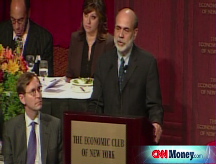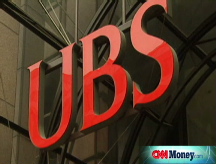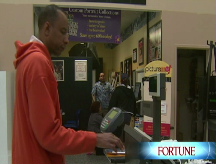Lenders start loosening grip
Frozen pipelines show signs of a thaw as the overnight and 3-month bank-to-bank rates edge lower. Treasury prices churn.
NEW YORK (CNNMoney.com) -- The credit markets showed further signs of improvement Thursday, as bank-to-bank lending rates eased further away from recent highs but there is still a long way to go before breaking out the champagne.
"We are seeing some ongoing angst with respect to lending longer term," said Kim Rupert, fixed income analyst at Action Economics. "Those rates are coming down only very grudgingly."
The overnight Libor rate fell Thursday to 1.94% - its lowest level since Nov. 9, 2004 - from 2.14% the previous day, according to the British Bankers Association.
Libor is a daily average of what 16 different banks charge other banks to lend money in London and is used to calculate adjustable rate mortgages. The higher the rate, the tougher it could be for homeowners to pay those mortgages.
A week ago, the overnight Libor was 5.09% and had spiked as high as 6.88% after the U.S. $700 billion bailout bill was signed into law on Oct. 3.
Meanwhile, the 3-month Libor edged lower to 4.50% from the previous day's rate of 4.55%, according to Bloomberg.com. While the rate has been easing, it remains at elevated levels. Just last week, it had surged to 4.82% - the highest since mid-December 2007. By comparison, it was only 2.82% a month ago.
Banks had already gotten stingy with lending, starting with the implosion of the housing crisis last summer. But they've took it to another level after Lehman Brothers declared bankruptcy last month because they didn't want to lend to another financial institution without any ironclad guarantees that the money would be returned.
The risk increases with the length of the loan. "You are pretty well assured of getting your money back if you do an overnight or one week transaction," said Rupert. However, longer-term loans are a "dicey proposition" for a lot of lenders right now, according to Rupert.
As the government makes unprecedented efforts to salvage the economy, there will be "unknown implications that surface," said William Larkin, portfolio manager at Cabot Money Management.
Similarly, corporations are having a harder time finding buyers for their bonds. "The government is really taking care to make sure that the banks lend to each other," said Larkin, but it is harder to guarantee that those banks are going to lend to turn around and lend to companies and individuals.
Another key form of lending to major businesses and banks, known as commercial paper, remained tight with the market contracting for five straight weeks. Total outstanding commercial paper fell 2.6% in the last week and, while that was another drop, the pace of the decline was easing.
Cracks in the ice: Two market indicators signal some modest improvement.
The "TED spread" retreated to 4.11% from 4.27% earlier, slightly lower than 4.37% Wednesday. The TED spread measures the difference between the 3-month Libor and the 3-month Treasury bill, and is a key indicator of risk. The higher the spread, the more unwilling investors are to take risks. The spread was 1.04% just a little over a month ago and had reached a record high of 4.65% on Friday.
Another indicator, the Libor-OIS spread, edged up to 3.42% and then retreated again to 3.39% from 3.41% on Wednesday. The Libor-OIS spread measures how much cash is available for lending between banks, and is used for determining lending rates. The bigger the spread, the less cash is available for lending.
Mortgage rates: Mortgage rates have been rising. Thursday, the Freddie Mac reported the average 30-year fixed-rate mortgage was up at 6.46% from 5.94% the week earlier. For the week ended Oct. 10, the average interest rate for 30-year fixed rate mortgage jumped to 6.47% from 5.99%, according to a report from the Mortgage Bankers Association released Wednesday.
One of the reason's that mortgage rates have been ticking higher is that Fannie Mae and Freddie Mac have to compete with banks for investors to purchase their debt, now that the government has stepped in to support the banks.
"The government is now backing new bank debt because they are trying to help the banks," said Larkin. However, that "puts Fannie an Freddie in a more difficult situation," said Larkin, because it is harder for those mortgage-backers to obtain capital.
Seeking safety: Treasury prices churned Thursday as investors weighed a jolt of supply, injected by the Treasury Department to fund its various bailout plans, against the desire to protect assets.
Bonds were also reacting to the equity markets, which opened modestly higher before quickly selling off. Investors tend to move their assets in and out of government bonds as the perceived risk of the stock market fluctuates.
The benchmark 10-year note was up 4/32 at 100-17/32 and its yield ticked slightly lower to 3.94%. The yield decline, while modest, could bode well for the mortgage market. Because fixed mortgage rates closely track the 10-year yield, when the yield falls, mortgage rates tend to follow.
The 30-year bond was down 23/32 to 104-12/32 and its yield was 4.24%, up from 4.19% Wednesday. Bond prices and yields move in opposite directions. The 2-year note ticked up 1/32 to 100-28/32 and its yield was 1.56%.
The yield on the 3-month bill was 0.39%, higher than 0.22% late Wednesday.
The yield on the 3-month Treasury bill is closely watched as an immediate reading on investor confidence. Investors and money-market funds shuffle funds into and out of the 3-month bill frequently, as they assess risk in the rest of the marketplace.
Furthermore, the Treasury is lining up a series of auctions to help fund its plans for helping financial institutions.
On Thursday, the Treasury will auction $35 billion worth of 191-day cash management bills and another $35 billion worth of 247-day cash management bills. A cash management bill are a form of short-term securities offered as needed by the government.
Friday, the Treasury will offer $30 billion worth of 74-day bills and another $30 billion worth of 94-day bills. The $60 billion worth of notes the government plans to auction Friday are part of the Supplementary Financing Program that the government announced on Sept. 17 to "provide cash for use in the Federal Reserve initiatives," according to a statement on the Treasury Web site.
As credit pipelines seized up in the U.S., economies around the world stalled. The government planned a series of global, coordinated steps to shore up investor confidence and encourage banks to start lending to each other both domestically and abroad. ![]()






